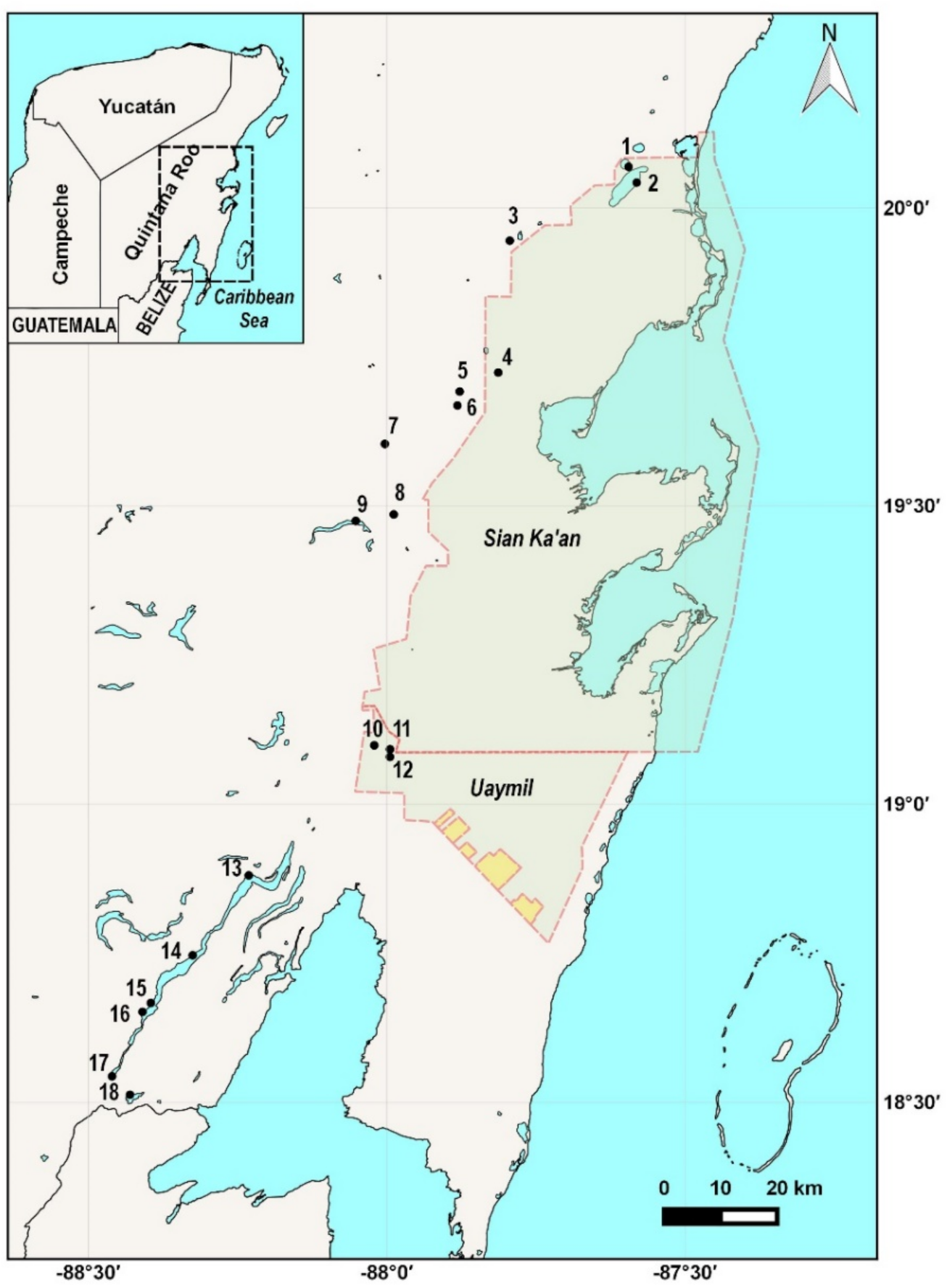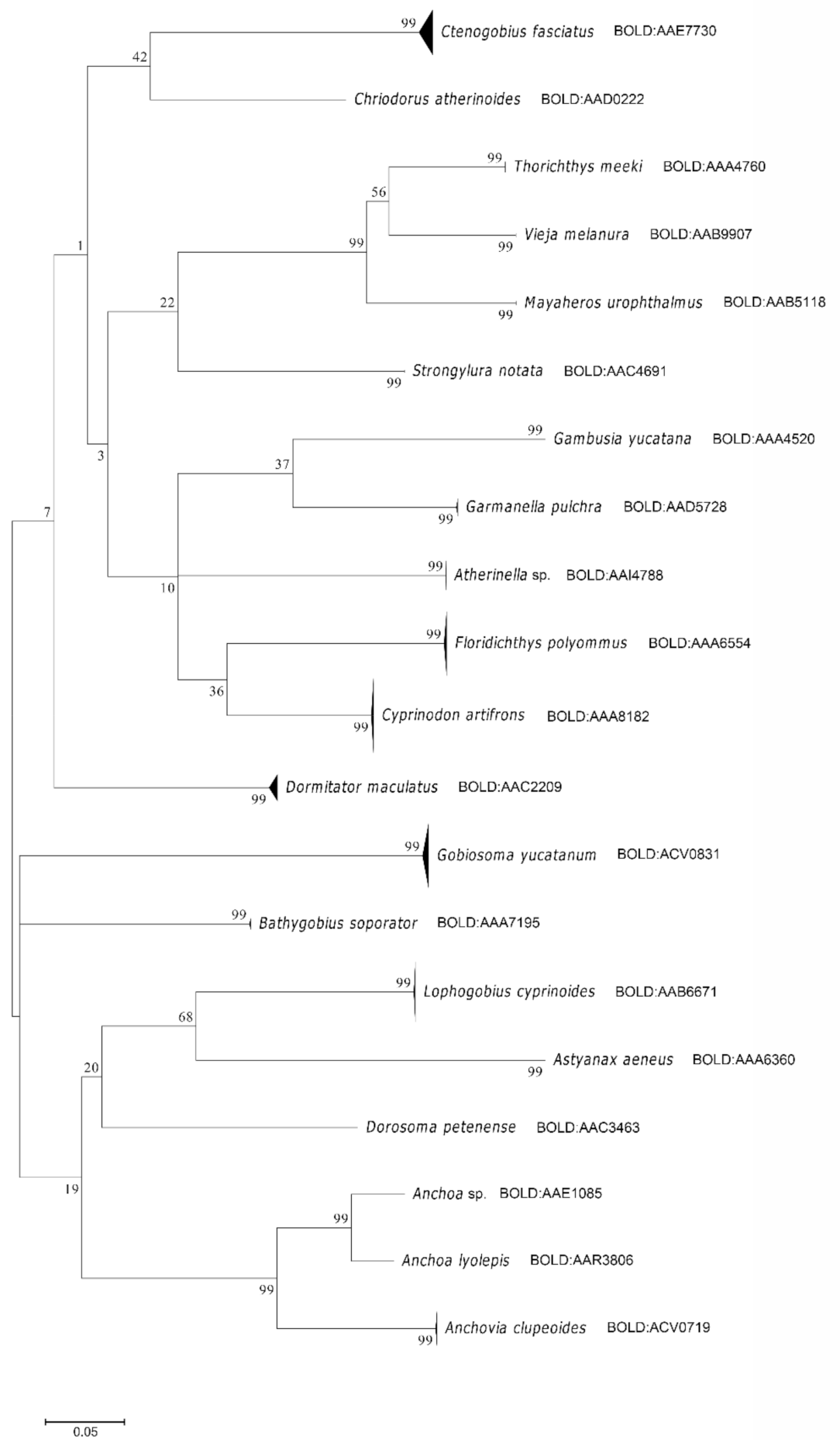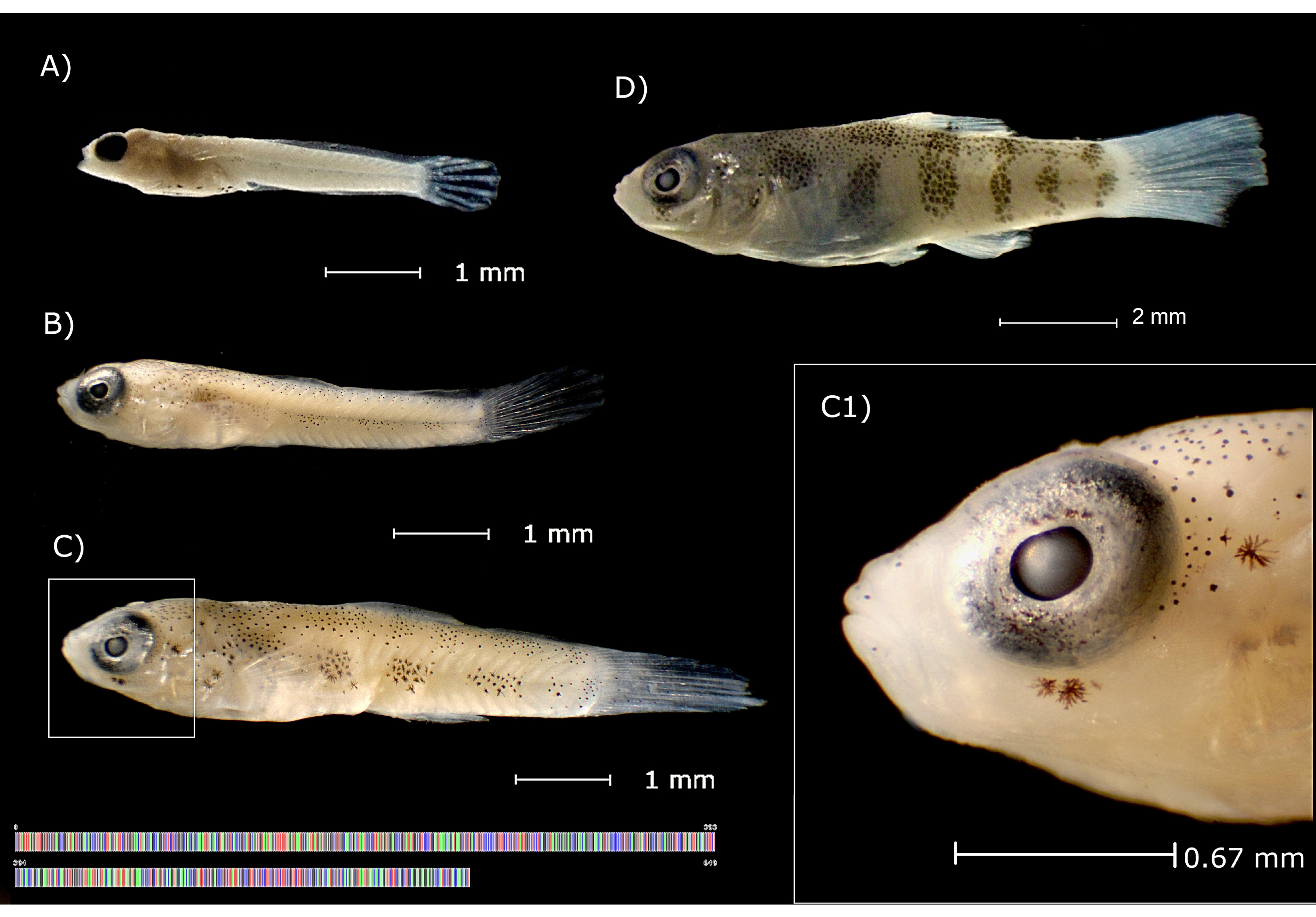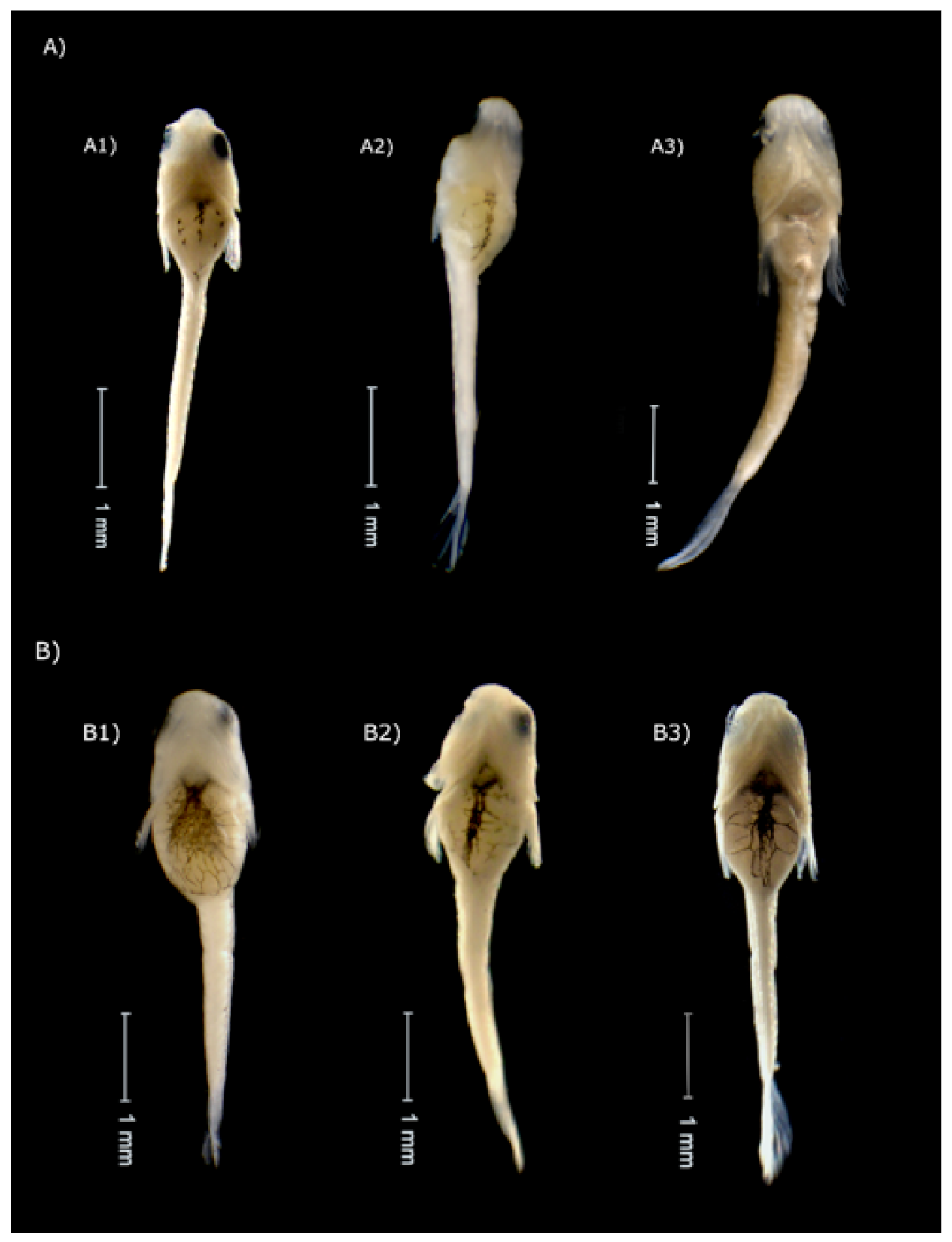Identifying Early Stages of Freshwater Fish with DNA Barcodes in Several Sinkholes and Lagoons from the East of Yucatan Peninsula, Mexico
Abstract
1. Introduction
2. Materials and Methods
2.1. Study Site and Field Sampling
2.2. Morphological Analysis
2.3. DNA Barcode Analysis
2.4. Data Analysis
3. Results and Discussion
3.1. Species Identification
3.2. Cyprinodon Artifrons (Hubbs, 1936)
3.3. Floridichthys Polyommus (Hubbs, 1936)
4. Conclusions
Supplementary Materials
Author Contributions
Funding
Institutional Review Board Statement
Data Availability Statement
Acknowledgments
Conflicts of Interest
References
- SECTUR. Results of Tourism Activity Mexico. Available online: http://www.acs-aec.org/sites/default/files/20150515_rat_a_marzo_15_en.pdf (accessed on 31 August 2021).
- Sánchez-Flores, E. La Contribución Del Turismo Al Crecimiento Económico: Análisis Regional En México. Transitare 2016, 2, 183–204. [Google Scholar]
- Martos-López, L.A. Underwater Archaeological Exploration of the Mayan Cenotes. Mus. Int. 2008, 60, 100–110. [Google Scholar] [CrossRef]
- Campbell, M.; Withers, K.; Tolan, J. Occurrence of Larval and Juvenile Fish in Mangrove Habitats in the Sian Ka’an Biosphere Reserve, Quintana Roo, Mexico. Gulf Caribb. Res. 2008, 20, 81–86. [Google Scholar] [CrossRef][Green Version]
- Quintal-Lizama, C.; Vásquez-Yeomans, L. Asociaciones de Larvas de Peces En Una Bahía Del Caribe Mexicano. Rev. Biol. Trop. 2001, 49, 11. [Google Scholar]
- Sanvicente-Añorve, L.; Hernández-Gallardo, A.; Gómez-Aguirre, S.; Flores-Coto, C. Fish Larvae from a Caribbean Estuarine System in Book The Big Fish Bang, 1st ed.; Browman, H.I., Skiftesvik, A.B., Eds.; The Instituto Marine Research: Bergen, Norway, 2003; pp. 365–379. [Google Scholar]
- Valdez-Moreno, M.; Vásquez-Yeomans, L.; Elías-Gutiérrez, M.; Ivanova, N.; Hebert, P.D.N. Using DNA Barcodes to Connect Adults and Early Life Stages of Marine Fishes from the Yucatan. Mar. Freshw. Res. 2010, 61, 665–671. [Google Scholar] [CrossRef]
- Victor, B.; Vásquez-Yeomans, L.; Valdez-Moreno, M.; Wilk, L.; Jones, D.; Shivji, M.; Lara, M.; Caldow, C. The Larval, Juvenile, and Adult Stages of the Caribbean Goby, Coryphopterus Kuna (Teleostei: Gobiidae): A Reef Fish with a Pelagic Larval Duration Longer than the Post-Settlement Lifespan. Zootaxa 2010, 2346, 53–61. [Google Scholar] [CrossRef]
- Richards, W.J. Early Stages of Atlantic Fishes, 1st ed.; CRC Press: Boca Raton, FL, USA, 2005. [Google Scholar]
- Rodríguez, J.M.; Alemany, F.; García, A. A Guide to the Eggs and Larvae of 100 Common Western Mediterranean Sea Bony Fish Species; The Food and Agriculture Organization: Rome, Italy, 2017. [Google Scholar]
- Elías-Gutiérrez, M.; Valdez-Moreno, M.; Topan, J.; Young, M.; Cohuo-Colli, J. Improved Protocols to Accelerate the Assembly of DNA Barcode Reference Libraries for Freshwater Zooplankton. Ecol. Evol. 2018, 8, 3002–3018. [Google Scholar] [CrossRef]
- Ko, H.L.; Wang, Y.T.; Chiu, T.S.; Lee, M.A.; Leu, M.Y.; Chang, K.Z.; Chen, W.Y.; Shao, K.T. Evaluating the Accuracy of Morphological Identification of Larval Fishes by Applying DNA Barcoding. PLoS ONE 2013, 8, 3–9. [Google Scholar] [CrossRef]
- Dayrat, B. Towards Integrative Taxonomy. Biol. J. Linn. Soc. Lond. 2005, 85, 407–415. [Google Scholar] [CrossRef]
- Steele, P.R.; Pires, J.C. Biodiversity Assessment: State-of-the-Art Techniques in Phylogenomics and Species Identification. Am. J. Bot. 2011, 98, 415–425. [Google Scholar] [CrossRef]
- Baldwin, C.C.; Johnson, G.D. Connectivity across the Caribbean Sea: DNA Barcoding and Morphology Unite an Enigmatic Fish Larva from the Florida Straits with a New Species of Sea Bass from Deep Reefs off Curacao. PLoS ONE 2014, 9, e97661. [Google Scholar] [CrossRef]
- Krishnamurthy, K.P.; Francis, R.A. A Critical Review on the Utility of DNA Barcoding in Biodiversity Conservation. Biodivers. Conserv. 2012, 21, 1901–1919. [Google Scholar] [CrossRef]
- Hubert, N.; Delrieu-Trottin, E.; Irisson, J.O.; Meyer, C.; Planes, S. Identifying Coral Reef Fish Larvae through DNA Barcoding: A Test Case with the Families Acanthuridae and Holocentridae. Mol. Phylogenet. Evol. 2010, 55, 1195–1203. [Google Scholar] [CrossRef]
- Baldwin, C.; Brito, B.; Smith, D.; Weigt, L.; Escobar-Briones, E. Identification of Early Life-History Stages of Caribbean Apogon (Perciformes: Apogonidae) through DNA Barcoding. Zootaxa 2011, 3133, 1–36. [Google Scholar] [CrossRef]
- Prosser, S.; Martínez-Arce, A.; Elías-Gutiérrez, M. A New Set of Primers for COI Amplification from Freshwater Microcrustaceans. Mol. Ecol. Resour. 2013, 13, 1151–1155. [Google Scholar] [CrossRef]
- Fahay, M.P. Early Stages of Fishes in the Western North Atlantic Ocean: Davis Strait, Southern Greenland and Flemish Cap to Cape Hatteras; Northwest Atlantic Fisheries Organization: Dartmouth, NS, Canada, 2007. [Google Scholar]
- Beeching, S.C.; Pike, R.E. Ontogenetic Color Change in the Firemouth Cichlid, Thorichthys Meeki. Copeia 2010, 2010, 189–195. [Google Scholar] [CrossRef]
- Miller, R.R.; Minckley, W.L.; Norris, S.M. Peces Dulceacuícolas de México, 1st ed.; CONABIO: Tlalpan, DF, Mexico, 2009. [Google Scholar]
- Schmitter-Soto, J.J. Catalogo de Los Peces Continentales de Quintana Roo; El Colegio de la Frontera Sur: San Cistóbal de las Casas, Chiapas, Mexico, 1998. [Google Scholar]
- Valdez-Moreno, M.; Ivanova, N.V.; Elías-Gutiérrez, M.; Pedersen, S.L.; Bessonov, K.; Hebert, P.D.N. Using eDNA to Biomonitor the Fish Community in a Tropical Oligotrophic Lake. PLoS ONE 2019, 14, e0215505. [Google Scholar] [CrossRef]
- Valdez-Moreno, M.; Elías-Gutiérrez, M.; Mendoza-Carranza, M.; Rendón-Hernández, E.; Alarcón-Chavira, E. DNA Barcodes Applied to a Rapid Baseline Construction in Biodiversity Monitoring for the Conservation of Aquatic Ecosystems in the Sian Ka’an Reserve (Mexico) and Adjacent Areas. Diversity 2021, 13, 292. [Google Scholar] [CrossRef]
- Ivanova, N.V.; Dewaard, J.R.; Hebert, P.D.N. An Inexpensive, Automation-Friendly Protocol for Recovering High-Quality DNA. Mol. Ecol. Notes 2006, 6, 998–1002. [Google Scholar] [CrossRef]
- Hebert, P.D.N.; Cywinska, A.; Ball, S.L.; Dewaard, J.R. Biological Identifications through DNA Barcodes. Proc. R. Soc. B 2003, 270, 313–321. [Google Scholar] [CrossRef]
- Ward, R.D.; Zemlak, T.S.; Innes, B.H.; Last, P.R.; Hebert, P.D.N. DNA Barcoding Australia’s Fish Species. Philos. Trans. R. Soc. London B Biol. Sci. 2005, 360, 1847–1857. [Google Scholar] [CrossRef]
- Ivanova, N.V.; Zemlak, T.S.; Hanner, R.H.; Hebert, P.D.N. Universal Primer Cocktails for Fish DNA Barcoding. Mol. Ecol. Notes 2007, 7, 544–548. [Google Scholar] [CrossRef]
- Ratnasingham, S.; Hebert, P.D.N. Bold: The Barcode of Life Data System (Www.Barcodinglife.Org). Mol. Ecol. Notes 2007, 7, 355–364. [Google Scholar] [CrossRef]
- Ratnasingham, S.; Hebert, P.D. A DNA-Based Registry for All Animal Species: The Barcode Index Number (BIN) System. PLoS ONE 2013, 8, e66213. [Google Scholar] [CrossRef] [PubMed]
- Kimura, M. A Simple Method for Estimating Evolutionary Rates of Base Substitutions through Comparative Studies of Nucleotide Sequences. J. Mol. Evol. 1980, 16, 111–120. [Google Scholar] [CrossRef]
- Saitou, N.; Nei, M. The Neighbor-Joining Method: A New Method for Reconstructing Phylogenetic Trees. Mol. Biol. Evol. 1987, 4, 406–425. [Google Scholar] [CrossRef]
- Kumar, S.; Stecher, G.; Tamura, K. MEGA7: Molecular Evolutionary Genetics Analysis Version 7.0 for Bigger Datasets. Mol. Biol. Evol. 2016, 33, 1870–1874. [Google Scholar] [CrossRef]
- Sarmiento-Camacho, S.; Valdez-Moreno, M. DNA Barcode Identification of Commercial Fish Sold in Mexican Markets. Genome 2018, 61, 457–466. [Google Scholar] [CrossRef]
- Almeida, F.S.; Frantine-Silva, W.; Lima, S.C.; Garcia, D.A.Z.; Orsi, M.L. DNA Barcoding as a Useful Tool for Identifying Non-Native Species of Freshwater Ichthyoplankton in the Neotropics. Hydrobiologia 2018, 817, 111–119. [Google Scholar] [CrossRef]
- Pegg, G.; Sinclair, B.; Briskey, L.; Aspden, W. MtDNA Barcode Identification of Fish Larvae in the Southern Great Barrier Reef, Australia. Sci. Mar. 2006, 70, 7–12. [Google Scholar] [CrossRef]
- Loh, W.K.W.; Bond, P.; Ashton, K.J.; Roberts, D.T.; Tibbetts, I.R. DNA Barcoding of Freshwater Fishes and the Development of a Quantitative QPCR Assay for the Species-Specific Detection and Quantification of Fish Larvae from Plankton Samples. J. Fish Biol. 2014, 85, 307–328. [Google Scholar] [CrossRef] [PubMed]
- Frantine-Silva, W.; Sofia, S.H.; Orsi, M.L.; Almeida, F.S. DNA Barcoding of Freshwater Ichthyoplankton in the Neotropics as a Tool for Ecological Monitoring. Mol. Ecol. Resour. 2015, 15, 1226–1237. [Google Scholar] [CrossRef] [PubMed]
- Meusnier, I.; Singer, G.A.C.; Landry, J.-F.; Hickey, D.A.; Hebert, P.D.N.; Hajibabaei, M. A Universal DNA Mini-Barcode for Biodiversity Analysis. BMC Genom. 2008, 9, 214. [Google Scholar] [CrossRef] [PubMed]
- Bhattacharjee, M.J.; Ghosh, S.K. Design of Mini-Barcode for Catfishes for Assessment of Archival Biodiversity. Mol. Ecol. Resour. 2014, 14, 469–477. [Google Scholar] [CrossRef]
- Fields, A.T.; Abercrombie, D.L.; Eng, R.; Feldheim, K.; Chapman, D.D. A Novel Mini-DNA Barcoding Assay to Identify Processed Fins from Internationally Protected Shark Species. PLoS ONE 2015, 10, e0114844. [Google Scholar] [CrossRef]
- Shokralla, S.; Hellberg, R.; Handy, S.; King, I.; Hajibabaei, M. A DNA Mini-Barcoding System for Authentication of Processed Fish Products OPEN. Sci. Rep. 2015, 5, 15894. [Google Scholar] [CrossRef]
- Dhar, B.; Ghosh, S.K. Mini-DNA Barcode in Identification of the Ornamental Fish: A Case Study from Northeast India. Gene 2017, 627, 248–254. [Google Scholar] [CrossRef]
- Bénard-Capelle, J.; Guillonneau, V.; Nouvian, C.; Fournier, N.; Le Loët, K.; Dettai, A. Fish Mislabelling in France: Substitution Rates and Retail Types. PeerJ 2015, 2, e714. [Google Scholar] [CrossRef]
- Hanner, R.; Becker, S.; Ivanova, N.V.; Steinke, D. FISH-BOL and Seafood Identification: Geographically Dispersed Case Studies Reveal Systemic Market Substitution across Canada. Mitochondrial DNA 2011, 22, 106–122. [Google Scholar] [CrossRef]
- Valdez-Moreno, M.; Pool-Canul, J.; Contreras-Balderas, S. A Checklist of the Freshwater Ichthyofauna from El Petén and Alta Verapaz, Guatemala, with Notes for Its Conservation and Management. Zootaxa 2005, 1072, 43–60. [Google Scholar] [CrossRef]
- Anbarasi, G.; Vignesh, R.; Arulmoorthy, M.P.; Rathiesh, A.C.; Srinivasan, M. Barcoding Profiling and Intra Species Variation Within the Barcode Region of Two Estuarine Fishes Oreochromis Mossambicus and Oreochromis Niloticus. GJBB 2015, 4, 59–68. [Google Scholar]
- Whitehead, P.J.P.; Nelson, G.J.; Wongratana, T. FAO Species Catalogue, Clupeoid Fishes of the World (Engraulidae); FAO: Rome, Italy, 1988; pp. 305–579. [Google Scholar]
- Dawson, C.E. Gobiosoma (Garmannia) Yucatanum, a New Seven-Spined Atlantic Goby from Mexico. Copeia 1971, 1971, 432–439. [Google Scholar] [CrossRef]
- Greendfield, D.W.; Thomerson, J.E. Fishes of the Continental Waters of Belize, 1st ed.; University Press of Florida: Gainesville, FL, USA, 1997. [Google Scholar]
- FishBase. Available online: http://www.fishbase.org (accessed on 29 July 2021).
- López-Vila, J.M.; Valdez-Moreno, M.; Schmitter-Soto, J.J.; Mendoza-Carranza, M.; Herrera-Pavón, R.L. Composición y Estructura de La Ictiofauna Del Río Hondo, México-Belice, Con Base En El Uso Del Arpón. Rev. Mex. Biodivers. 2014, 85, 866–874. [Google Scholar] [CrossRef]
- Zambrano, L.; Vázquez-Domínguez, E.; Garcia-Bedoya, D.; Loftus, W.; Trexler, J. Fish Community Structure in Freshwater Karstic Water Bodies of the Sian Ka’an Reserve in the Yucatan Peninsula, Mexico. Ichthyol. Explor. Freshw. 2006, 17, 193–206. [Google Scholar]
- Escalera-Vázquez, L.H.; Zambrano, L. The Effect of Seasonal Variation in Abiotic Factors on Fish Community Structure in Temporary and Permanent Pools in a Tropical Wetland. Freshw. Biol. 2010, 55, 2557–2569. [Google Scholar] [CrossRef]
- Camargo-Guerra, T.; Escalera-Vázquez, L.H.; Zambrano, L. Fish Community Structure Dynamics in Cenotes of the Biosphere Reserve of Sian Ka’an, Yucatán Peninsula, Mexico. Rev. Mex. Biodivers. 2013, 84, 901–911. [Google Scholar] [CrossRef]
- Montes-Ortiz, L.; Elías-Gutiérrez, M. Faunistic Survey of the Zooplankton Community in an Oligotrophic Sinkhole, Cenote Azul (Quintana Roo, Mexico), Using Different Sampling Methods, and Documented with DNA Barcodes. J. Limnol. 2018, 77, 428–440. [Google Scholar] [CrossRef]
- Vásquez-Yeomans, L.; Vega-Cendejas, M.E.; Montero, J.L.; Sosa-Cordero, E. High Species Richness of Early Stages of Fish in a Locality of the Mesoamerican Barrier Reef System: A Small-Scale Survey Using Different Sampling Gears. Biodivers. Conserv. 2011, 20, 2379–2392. [Google Scholar] [CrossRef]
- Magalhães, A.L.B.; Orsi, M.L.; Pelicice, F.M.; Azevedo-Santos, V.M.; Vitule, J.R.S.; Lima-Junior, D.P.; Brito, M.F.G. Small Size Today, Aquarium Dumping Tomorrow: Sales of Juvenile Non-Native Large Fish as an Important Threat in Brazil. Neotrop. Ichthyol. 2017, 15, e170033. [Google Scholar] [CrossRef]
- Trujillo-Jiménez, P.; Sedeño-Díaz, J.E.; López-López, E. Reproductive Traits of the “Ocellated Killifish” Floridichthys Polyommus Hubbs, 1936 (Pisces: Cyprinodontidae) Inhabiting Estuary of the Champotón River (Campeche, Mexico). J. Appl. Ichthyol. 2018, 34, 806–814. [Google Scholar] [CrossRef]
- Koumoundouros, G.; Gagliardi, F.; Divanach, P.; Boglione, C.; Cataudella, S.; Kentouri, M. Normal and Abnormal Osteological Development of Caudal Fin in Sparus Aurata L. Fry. Aquaculture 1997, 149, 215–226. [Google Scholar] [CrossRef]
- Faustino, M.; Power, D.M. Development of the Pectoral, Pelvic, Dorsal and Anal Fins in Cultured Sea Bream. J. Fish Biol. 1999, 54, 1094–1110. [Google Scholar] [CrossRef]
- López, N.; Ruíz, C.; Landines, M. Descripcion Macroscopica Del Desarrollo Larval Del Coporo (Prochilodus Mariae). Rev. Fac. Med. Vet. Zootec. 2005, 52, 110–119. [Google Scholar] [CrossRef]
- Thorsen, D.H.; Hale, M.E. Development of Zebrafish (Danio Rerio) Pectoral Fin Musculature. J. Morphol. 2005, 266, 241–255. [Google Scholar] [CrossRef]
- Fuiman, L.A.; Conner, J.V.; Lathrop, B.F.; Buynak, G.L.; Snyder, D.E.; Loos, J.J. State of the Art of Identification for Cyprinid Fish Larvae from Eastern North America. Trans. Am. Fish. Soc. 1983, 112, 319–332. [Google Scholar] [CrossRef]





| Number | Site | Lat N | Long W | Number of Light Traps Per Day | Date |
|---|---|---|---|---|---|
| 1 | Muyil Lagoon * | 20.069 | −87.594 | 2 | 24 August 2019 |
| 2 | Chunyaxche lagoon * | 20.042 | −87.581 | 2 | 24 August 2019 |
| 3 | Km 48 sinkhole ** | 19.943 | −87.794 | 1 | 24 August 2019 |
| 4 | Santa Teresa sinkhole * | 19.723 | −87.813 | 1 | 23 August 2019 |
| 5 | Tres Reyes 2 sinkhole ** | 19.692 | −87.877 | 1 | 23 August 2019 |
| 6 | Tres Reyes 1 sinkhole ** | 19.668 | −87.881 | 1 | 23 August 2019 |
| 7 | Del Padre sinkhole ** | 19.604 | −88.003 | 2 | 23 August 2019 |
| 8 | Chancah Veracruz sinkhole ** | 19.486 | −87.988 | 2 | 22 August 2019 |
| 9 | Siijil Noh Ha sinkhole ** | 19.475 | −88.052 | 2 | 22 August 2019 |
| 10 | El Toro sinkhole ** | 19.098 | −88.021 | 1 | 22 August 2019 |
| 11 | Pucté 2 sinkhole ** | 19.091 | −87.994 | 1 | 25 August 2019 |
| 12 | Pucté-Cafetal sinkhole ** | 19.079 | −87.994 | 1 | 25 August 2019 |
| 13 | Buena Vista *** | 18.88 | −88.231 | 1 | 17 August 2015 |
| 14 | Cayuco Maya *** | 18.746 | −88.325 | 1 | 18 August 2015 |
| 15 | Brujas sinkhole *** | 18.666 | −88.395 | 1 | 28 June 2015 |
| 1 August 2019 | |||||
| 16 | Cocalitos sinkhole *** | 18.651 | −88.409 | 1 | 2 August 2015 |
| 18 April 2015 | |||||
| 28 June 2015 | |||||
| 19 July 2015 | |||||
| 20 August 2015 | |||||
| 1 December 2015 | |||||
| 17 | Xul-Ha lagoon | 18.543 | −88.46 | 1 | 15 August 2015 |
| 18 | Huay Pix lagoon | 18.512 | −88.43 | 1 | 14 August 2015 |
| Order | Family | Species | # Specimens | % Similarity | BIN |
|---|---|---|---|---|---|
| Atheriniformes | Atherinopsidae | Atherinella sp. | 22 | 100 | BOLD:AAI4788 |
| Beloniformes | Belonidae | Strongylura notata | 2 | 100 | BOLD:AAC4691 |
| Hemiramphidae | Chriodorus atherinoides | 1 | 100 | BOLD:AAD0222 | |
| Characiformes | Characidae | Astyanax aeneus | 3 | 100 | BOLD:AAA6360 |
| Cichliformes | Cichlidae | Mayaheros urophthalmus | 3 | 100 | BOLD:AAB5118 |
| Thorichthys meeki | 8 | 100 | BOLD:AAA4760 | ||
| Vieja melanura | 3 | 100 | BOLD:AAB9907 | ||
| Clupeiformes | Clupeidae | Dorosoma petenense | 1 | 100 | BOLD:AAC3463 |
| Engraulidae | Anchoa lyolepis | 1 | 99.85 | BOLD:AAR3806 | |
| Anchoa sp. | 1 | 100 | BOLD:AAE1085 | ||
| Anchovia clupeoides | 26 | 100 | BOLD:ACV0719 | ||
| Cyprinodontiformes | Cyprinodontidae | Cyprinodon artifrons | 56 | 100 | BOLD:AAA8182 |
| Floridichthys polyommus | 48 | 100 | BOLD:AAA6554 | ||
| Garmanella pulchra | 11 | 100 | BOLD:AAD5728 | ||
| Poeciliidae | Gambusia yucatana | 5 | 100 | BOLD:AAA4520 | |
| Gobiiformes | Eleotridae | Dormitator maculatus | 20 | 99.36–100 | BOLD:AAC2209 |
| Gobiidae | Bathygobius soporator | 7 | 100 | BOLD:AAA7195 | |
| Gobiosoma yucatanum | 50 | 100 | BOLD:ACV0831 | ||
| Lophogobius cyprinoides | 45 | 99.83–100 | BOLD:AAB6671 | ||
| Oxudercidae | Ctenogobius fasciatus | 34 | 100 | BOLD:AAE7730 |
| Specie | Size Range (mm) * LT ** LS | Number of Specimens | Stage | Collecting Sites | ||||||||||||||
|---|---|---|---|---|---|---|---|---|---|---|---|---|---|---|---|---|---|---|
| 1 | 2 | 3 | 7 | 8 | 9 | 10 | 11 | 12 | 13 | 14 | 15 | 16 | 17 | 18 | ||||
| Atherinella sp. | 3.2–7.2 * | 58 | Preflexion larvae | x | x | x | x | |||||||||||
| 11.5 | 1 | Postflexion larvae | x | x | ||||||||||||||
| 21–22 * | 3 | Transition stage | x | x | ||||||||||||||
| 27.5–42.5 * | 15 | Juvenil | x | |||||||||||||||
| Strongylura | 12 ** | 1 | Postflexion larvae | x | ||||||||||||||
| notata | 95 ** | 1 | Juvenil | x | ||||||||||||||
| Chriodorus atherinoides | 15 ** | 1 | Postflexion larvae | x | ||||||||||||||
| Astyanax aeneus | 33.7–40.2 * | 3 | Juvenil | x | ||||||||||||||
| Mayaheros | 6.5–6.9 * | 2 | Postflexion larvae | x | ||||||||||||||
| urophthalmus | 14.4–17.50 * | 2 | Transition stage | x | ||||||||||||||
| Thorichthys | 4.5–5 | 3 | Flexion larvae | x | ||||||||||||||
| meeki | 6.5–7.4 * | 7 | Postflexion larvae | x | ||||||||||||||
| Vieja melanura | 9.8 * | 1 | Postflexion larvae | x | ||||||||||||||
| 14.4–15 * | 2 | Transition stage | x | |||||||||||||||
| Dorosama petenense | 4 ** | 4 | Preflexion larvae | x | ||||||||||||||
| Anchoa lyolepis | 30 ** | 1 | Transition stage | x | ||||||||||||||
| Anchoa sp. | 21 ** | 1 | Transition stage | x | ||||||||||||||
| Anchovia | 3 ** | 1 | Preflexion larvae | x | ||||||||||||||
| clupeoides | 7 ** | 6 | Flexion larvae | x | ||||||||||||||
| 11–23 ** | 52 | Postflexion larvae | x | x | x | |||||||||||||
| 37–47 | 5 | Juvenile | x | |||||||||||||||
| Cyprinodon | 4.2–6.9 * | 49 | Postflexion larvae | x | x | x | ||||||||||||
| artifrons | 9–11 * | 11 | Transition stage | x | x | |||||||||||||
| Floridichthys | 4.5–8.5 * | 84 | Postflexion larvae | x | x | |||||||||||||
| polyommus | 9–10 * | 3 | Transition stage | x | ||||||||||||||
| 24.2 * | 1 | Juvenil | x | |||||||||||||||
| Garmanella | 4.2–4.5 * | 3 | Postflexion larvae | x | x | |||||||||||||
| pulchra | 11–12 * | 2 | Transition stage | x | ||||||||||||||
| 14.2–20 * | 6 | Juvenil | x | x | ||||||||||||||
| Gambusia yucatana | 7.9–8.2 * | 6 | Postflexion larvae | x | ||||||||||||||
| Dormitator | 5.2–13.6 * | 529 | Postflexion larvae | x | x | x | x | |||||||||||
| maculatus | 14.2–16.8 * | 26 | Transition stage | x | x | x | ||||||||||||
| Bathygobius | 2–2.2 ** | 38 | Preflexion larvae | x | ||||||||||||||
| soporator | 7 ** | 2 | Postflexion larvae | x | ||||||||||||||
| Gobiosoma | 2.2–3.5 ** | 72 | Preflexion larvae | x | x | |||||||||||||
| yucatanum | 3.8–4.6 ** | 216 | Flexion larvae | x | ||||||||||||||
| 4.8–11 ** | 270 | Posflexion larvae | x | x | ||||||||||||||
| 13 ** | 1 | Transition stage | x | |||||||||||||||
| Lophogobius | 2.8–3.2 ** | 157 | Preflexion larvae | x | x | |||||||||||||
| cyprinoides | 3.4–4 ** | 420 | Flexion larvae | x | x | x | ||||||||||||
| 4.3–8 ** | 415 | Postflexion larvae | x | x | x | |||||||||||||
| Ctenogobius | 3.3–3.4 ** | 29 | Preflexion larvae | x | ||||||||||||||
| fasciatus | 3.5–3.8 ** | 94 | Flexion larvae | x | ||||||||||||||
| 4.5–11 ** | 427 | Postflexion larvae | x | x | ||||||||||||||
| unidentified organisms | 164 | x | x | |||||||||||||||
| Total | 3195 | |||||||||||||||||
Publisher’s Note: MDPI stays neutral with regard to jurisdictional claims in published maps and institutional affiliations. |
© 2021 by the authors. Licensee MDPI, Basel, Switzerland. This article is an open access article distributed under the terms and conditions of the Creative Commons Attribution (CC BY) license (https://creativecommons.org/licenses/by/4.0/).
Share and Cite
Uh-Navarrete, A.E.; Villegas-Sánchez, C.A.; Cohuo-Colli, J.A.; Ortíz-Moreno, Á.O.; Valdez-Moreno, M. Identifying Early Stages of Freshwater Fish with DNA Barcodes in Several Sinkholes and Lagoons from the East of Yucatan Peninsula, Mexico. Diversity 2021, 13, 513. https://doi.org/10.3390/d13110513
Uh-Navarrete AE, Villegas-Sánchez CA, Cohuo-Colli JA, Ortíz-Moreno ÁO, Valdez-Moreno M. Identifying Early Stages of Freshwater Fish with DNA Barcodes in Several Sinkholes and Lagoons from the East of Yucatan Peninsula, Mexico. Diversity. 2021; 13(11):513. https://doi.org/10.3390/d13110513
Chicago/Turabian StyleUh-Navarrete, Adrián Emmanuel, Carmen Amelia Villegas-Sánchez, José Angel Cohuo-Colli, Ángel Omar Ortíz-Moreno, and Martha Valdez-Moreno. 2021. "Identifying Early Stages of Freshwater Fish with DNA Barcodes in Several Sinkholes and Lagoons from the East of Yucatan Peninsula, Mexico" Diversity 13, no. 11: 513. https://doi.org/10.3390/d13110513
APA StyleUh-Navarrete, A. E., Villegas-Sánchez, C. A., Cohuo-Colli, J. A., Ortíz-Moreno, Á. O., & Valdez-Moreno, M. (2021). Identifying Early Stages of Freshwater Fish with DNA Barcodes in Several Sinkholes and Lagoons from the East of Yucatan Peninsula, Mexico. Diversity, 13(11), 513. https://doi.org/10.3390/d13110513






